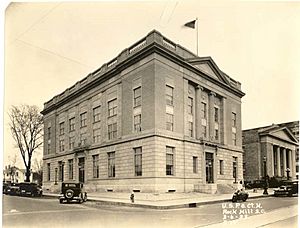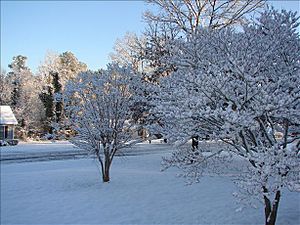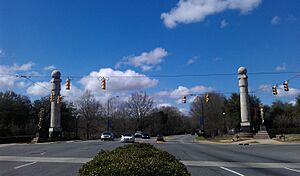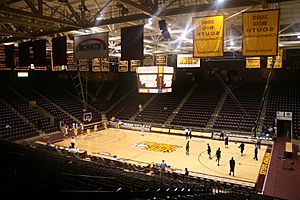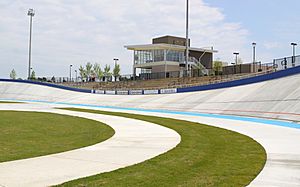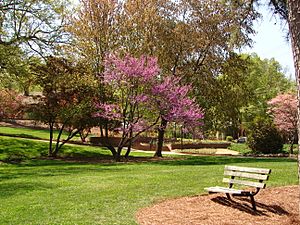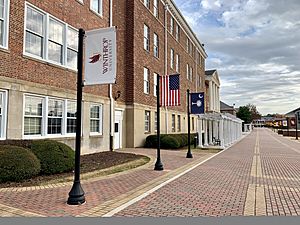Rock Hill, South Carolina facts for kids
Quick facts for kids
Rock Hill
|
|||
|---|---|---|---|

Downtown Rock Hill
|
|||
|
|||
| Nickname(s):
The Gateway to South Carolina, Football City USA
|
|||
| Motto(s):
"Always On."
|
|||
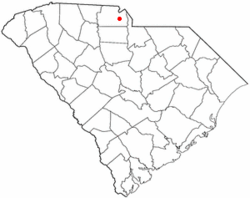
Location in South Carolina
|
|||
| Country | United States | ||
| State | South Carolina | ||
| County | York | ||
| Founded | 1852 | ||
| Incorporated | 1892 | ||
| Named for | A rocky hill encountered by railway builders | ||
| Government | |||
| • Type | Council-Manager | ||
| Area | |||
| • Total | 43.85 sq mi (113.58 km2) | ||
| • Land | 43.69 sq mi (113.17 km2) | ||
| • Water | 0.16 sq mi (0.41 km2) 0.36% | ||
| Elevation | 676 ft (206 m) | ||
| Population
(2020)
|
|||
| • Total | 74,372 | ||
| • Estimate
(2023)
|
75,654 | ||
| • Density | 1,702.11/sq mi (657.19/km2) | ||
| • Urban | 218,443 (US: 176th) | ||
| • Urban density | 1,504.9/sq mi (581.0/km2) | ||
| Demonym(s) | Rock Hillian | ||
| Time zone | UTC−5 (Eastern) | ||
| • Summer (DST) | UTC−4 (Eastern) | ||
| ZIP codes |
29730 29731 29732 29733 29734
|
||
| Area code(s) | 803, 839 | ||
| FIPS code | 45-61405 | ||
| GNIS feature ID | 1250417 | ||
Rock Hill is a lively city in York County, South Carolina, United States. It is the biggest city in York County and the 5th largest in the state. Rock Hill is also the 4th largest city in the Charlotte metropolitan area, which includes cities like Charlotte and Gastonia. In 2020, about 74,372 people lived here.
The city is located about 25 miles (40 km) south of Charlotte. It is also about 70 miles (110 km) north of Columbia, the state capital.
Rock Hill has beautiful views along the Catawba River. You can find many nature trails, restaurants, and 31 parks in the city. These parks are used for both local and national events. The historic downtown area has 12 old buildings, some built as early as 1840. They now offer places to eat and shop. Rock Hill is also home to three colleges, including Winthrop University. This public university was founded in 1886 and has almost 6,000 students each year.
Contents
History of Rock Hill
Learn about how Rock Hill became the city it is today, from its earliest residents to important events.
Early People and Settlers
For thousands of years, different groups of indigenous peoples lived in the Piedmont area. The Catawba Indian Nation, who spoke a Siouan language, lived here when Europeans first arrived. Today, they are the only federally recognized tribe in South Carolina, and their members live near Rock Hill.
European settlers started arriving in the Rock Hill area in the 1830s and 1840s. However, Rock Hill only became a real town when the Charlotte and South Carolina Railroad decided to build a rail line through the area.
Originally, the railroad wanted to build a station in a nearby village called Ebenezerville. But the people there didn't want the noisy, dirty railroad in their village. So, the engineers decided to build the line two miles away, near a local landmark. Some stories say the engineers marked the spot on a map and called it "rocky hill."
Some early families of Rock Hill, like the Whites, Blacks, and Moores, thought a train station nearby would be a good idea. They let the railroad build on their land. Construction started in 1848. The first passenger train arrived on March 23, 1852. A few weeks later, on April 17, 1852, the first Rock Hill Post Office opened.
With a name, a railroad station, and a post office, more people started moving to Rock Hill. A general store opened in 1849 or 1850 to provide supplies for the workers. Templeton Black, a large landowner, decided to create a larger town. He hired a surveyor to plan a main street. Black sold his first piece of land on that street for $125 before the post office even opened. Other business people quickly bought plots too.
Rock Hill Academy, the first school, opened in September 1854. Most people called it Pine Grove Academy because it was in a pine grove. Ann Hutchinson White donated the land for the school. In 1856, the school had 60 male students. Later, a school for girls opened in the same place.
Important Early Facts
- Before December 1857: Rock Hill's first newspaper, The Indian Land Chronicle, started publishing. It was later renamed The Rock Hill Chronicle in 1860.
- Before 1860: Rock Hill had at least two doctors: Robert Hervey Hope and William Barron Fewell.
Rock Hill During the Civil War
Before the American Civil War began, about half of York County's 21,800 residents were enslaved people. They were very important for growing cotton in the area. Many men from the county joined the Confederate army. By the end of the war, 805 of these men had died, and hundreds more were hurt. Men from Rock Hill fought in many major Civil War battles.
Because of its location on the railroad, Rock Hill became a place where Confederate soldiers and supplies were moved. Since there was no local hospital, townspeople cared for sick and wounded soldiers in their homes. People fleeing the coastal blockade or General Sherman's troops also came to Rock Hill.
Starting in 1862, local farmers switched from growing cotton to growing corn to produce more food. Prices in Rock Hill changed often during the war due to shortages and the inflation of Confederate paper money.
Confederate General P. G. T. Beauregard set up a temporary base in Rock Hill on February 21, 1865. He ordered roads to Charlotte blocked to stop General Sherman from reaching the city. However, Sherman ended up going in a different direction.
When General Lee surrendered, a future Rock Hill resident was involved. Captain Robert Moorman Sims was sent to tell Union troops that the Confederate troops wanted a truce.
After the Civil War
The Civil War greatly changed life in Rock Hill. The town grew as war refugees, widows, and returning soldiers moved in. Wealthy families sold their land to manage financially. Town life became more important than rural life.
Around 1870, most merchants in Rock Hill were former Confederate soldiers or new business owners trying to start fresh. At that time, even the largest stores were only one story tall, and there were no sidewalks. The first drug store opened in the 1870s. In 1881, the town got its first paved sidewalk.
Becoming an Official City
Rock Hill didn't officially become a city until 1870, after two earlier attempts.
The first try was in 1855, but nothing happened. The second try was in 1868. The townspeople said Rock Hill had over 300 residents, 11 stores, two churches, and schools. But larger landowners didn't want the town to become official because of the taxes it would bring. They said there were only 100 residents, and many were temporary. This showed how Rock Hill was changing from a farming area to a business community. The state government didn't act on either request.
The third attempt in 1869 was successful. This time, 57 people signed in favor of becoming a city, and only seven were against it. Even though the opponents owned most of the land, they couldn't stop it this time. Rock Hill officially became a city on February 26, 1870.
The 1900s in Rock Hill
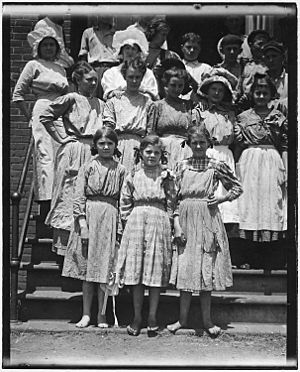
Rock Hill celebrated its 100th birthday in 1952 and its 150th birthday in 2002.
Four smaller communities near Rock Hill became part of the city:
Civil Rights Movement Events
Rock Hill was important during the civil rights movement.
In February 1961, nine African-American men went to jail. They had a sit-in at a segregated lunch counter in downtown Rock Hill. They were arrested for "refusing to stop singing hymns." These men used a new strategy called "jail, no bail." This meant they refused to pay bail, which helped civil rights groups save money. Their actions got national attention, and other groups started using this tactic. These men became known as the Friendship Nine because eight of them were students at Friendship Junior College in Rock Hill.
Later in 1961, Rock Hill was the first stop in the Deep South for the Freedom Riders. This group of 13 people traveled by bus from Washington, D.C., to test a 1960 Supreme Court ruling. This ruling said that racial segregation was illegal in all public facilities that crossed state lines. When civil rights leader John Lewis and another Black man got off the bus in Rock Hill, a white mob beat them. The police did not stop the attack. This event also drew national attention.
In 2002, John Lewis, who was then a U.S. Congressman, returned to Rock Hill. He spoke at Winthrop University and was given the key to the city. On January 21, 2008, Rep. Lewis came back again for the city's Martin Luther King, Jr. holiday event. Mayor Doug Echols officially apologized to him for how the Freedom Riders were treated in the city.
Geography and Nature
Rock Hill covers about 43.85 square miles (113.58 km2). Most of this area is land, with a small part being water.
The city is located along the Catawba River in the north-central part of the Piedmont region of South Carolina. It is south of Charlotte. Rock Hill is about 676 feet (206 meters) above sea level. It is also about 150 miles (240 km) from the Atlantic Ocean and 75 miles (120 km) from the Blue Ridge Mountains. The northern edge of the city is along Lake Wylie, a large man-made lake.
Rock Hill Neighborhoods
Rock Hill has many neighborhoods. Some of these used to be separate towns that later became part of Rock Hill.
- Downtown: This is the city's main business area. It has 12 historic buildings, some built as early as 1870. It's also where the city government offices and many restaurants are.
- Ebenezer: Located north of downtown along Ebenezer Road. This area has Piedmont Medical Center, new housing developments, and older neighborhoods.
- Oakdale: This area is in the southern part of the city. It is home to South Pointe High School and the Rock Hill Country Club golf course.
- Newport: Most of Newport has been added to the city. This area is growing fast with many new homes. It has the Rock Hill Aquatic Center and is northwest of Ebenezer.
- Boyd Hill: A historic neighborhood bordered by downtown to the south. It is home to the city's football and soccer stadium.
Weather and Climate
Rock Hill has a humid subtropical climate. This means it has four clear seasons: hot, humid summers and cool, dry winters. The coldest month is January, with average low temperatures around 31°F (-0.6°C). July is the hottest month, with average high temperatures around 91°F (32.8°C). The highest temperature ever recorded was 108°F (42.2°C) in 1983 and 2007. The lowest was -4°F (-20°C) in 1985. Rain doesn't change much between seasons.
| Climate data for Rock Hill, South Carolina (Winthrop University) 1991–2020 normals, extremes 1899–present | |||||||||||||
|---|---|---|---|---|---|---|---|---|---|---|---|---|---|
| Month | Jan | Feb | Mar | Apr | May | Jun | Jul | Aug | Sep | Oct | Nov | Dec | Year |
| Record high °F (°C) | 80 (27) |
83 (28) |
90 (32) |
96 (36) |
100 (38) |
105 (41) |
108 (42) |
106 (41) |
106 (41) |
98 (37) |
86 (30) |
81 (27) |
108 (42) |
| Mean daily maximum °F (°C) | 53.5 (11.9) |
57.8 (14.3) |
65.5 (18.6) |
74.8 (23.8) |
81.2 (27.3) |
87.6 (30.9) |
90.7 (32.6) |
89.0 (31.7) |
83.5 (28.6) |
74.0 (23.3) |
63.8 (17.7) |
55.6 (13.1) |
73.1 (22.8) |
| Daily mean °F (°C) | 43.0 (6.1) |
46.4 (8.0) |
53.5 (11.9) |
62.3 (16.8) |
69.9 (21.1) |
77.0 (25.0) |
80.2 (26.8) |
78.9 (26.1) |
73.3 (22.9) |
62.6 (17.0) |
52.3 (11.3) |
45.4 (7.4) |
62.1 (16.7) |
| Mean daily minimum °F (°C) | 32.6 (0.3) |
35.0 (1.7) |
41.6 (5.3) |
49.9 (9.9) |
58.6 (14.8) |
66.5 (19.2) |
69.7 (20.9) |
68.9 (20.5) |
63.0 (17.2) |
51.2 (10.7) |
40.9 (4.9) |
35.2 (1.8) |
51.1 (10.6) |
| Record low °F (°C) | −4 (−20) |
5 (−15) |
4 (−16) |
20 (−7) |
34 (1) |
40 (4) |
50 (10) |
49 (9) |
38 (3) |
25 (−4) |
12 (−11) |
2 (−17) |
−4 (−20) |
| Average precipitation inches (mm) | 3.58 (91) |
3.12 (79) |
3.90 (99) |
3.73 (95) |
3.53 (90) |
4.11 (104) |
3.57 (91) |
3.72 (94) |
3.56 (90) |
2.94 (75) |
3.28 (83) |
3.58 (91) |
42.62 (1,083) |
| Average precipitation days (≥ 0.01 in) | 9.9 | 9.4 | 10.1 | 8.7 | 8.4 | 9.3 | 9.1 | 9.2 | 6.6 | 6.8 | 7.7 | 9.2 | 104.4 |
| Source: NOAA | |||||||||||||
Notable Natural Disasters
Rock Hill has experienced several significant natural disasters.
1926 Rock Hill Tornado
On November 26, 1926, a powerful tornado hit downtown Rock Hill. It was unusual for such a strong storm to happen so late in the year. The "black as ink twister" changed the business area in less than 10 minutes. It damaged 60 homes, ripped off the hospital roof, and flipped cars. The total damage was $150,000, and it caused one death and 12 injuries.
Hurricane Hugo in 1989
Hurricane Hugo hit Rock Hill on September 22, 1989. The storm brought winds over 90 mph (145 km/h), knocking down many large oak and pine trees. Schools were closed for weeks because of widespread damage to roads and buildings. The storm caused about $4.2 billion in damage across South Carolina.
The Great Carolina Snowstorm of 2004
From February 25–27, 2004, a series of storms brought a lot of snow to Rock Hill. It started as a mix of snow and sleet, then turned into all snow. Cold arctic air settled over the area, dumping 22 inches (56 cm) of snow, with some areas getting up to 28 inches (71 cm). Strong winds over 40 mph (64 km/h) caused power outages, and schools were closed for a week. It was the worst blizzard to hit the area.
2011 Rock Hill Tornado
On November 14–16, 2011, a deadly EF-2 tornado struck about 8 miles (13 km) south and 5 miles (8 km) southwest of Rock Hill. It traveled for 2 miles (3.2 km) and had winds up to 135 mph (217 km/h). This storm caused 3 deaths, 5 injuries, and damaged 7-8 homes. These were the first tornado-related deaths ever recorded in York County.
Population and People
| Historical population | |||
|---|---|---|---|
| Census | Pop. | %± | |
| 1880 | 809 | — | |
| 1890 | 2,744 | 239.2% | |
| 1900 | 5,485 | 99.9% | |
| 1910 | 7,216 | 31.6% | |
| 1920 | 8,809 | 22.1% | |
| 1930 | 11,322 | 28.5% | |
| 1940 | 15,009 | 32.6% | |
| 1950 | 24,502 | 63.2% | |
| 1960 | 29,404 | 20.0% | |
| 1970 | 33,846 | 15.1% | |
| 1980 | 35,327 | 4.4% | |
| 1990 | 41,643 | 17.9% | |
| 2000 | 49,765 | 19.5% | |
| 2010 | 66,154 | 32.9% | |
| 2020 | 74,372 | 12.4% | |
| 2023 (est.) | 75,654 | 14.4% | |
| U.S. Decennial Census | |||
Rock Hill's Diverse Population
| Race | Num. | Perc. |
|---|---|---|
| White (non-Hispanic) | 35,264 | 47.42% |
| Black or African American (non-Hispanic) | 28,580 | 38.43% |
| Native American | 283 | 0.38% |
| Asian | 1,471 | 1.98% |
| Pacific Islander | 55 | 0.07% |
| Other/Mixed | 2,962 | 3.98% |
| Hispanic or Latino | 5,757 | 7.74% |
As of the 2020 United States census, Rock Hill had 74,372 people living in 32,341 households.
In 2010, the city had 66,154 people. The population was made up of different groups: 54.6% White, 38.3% Black, 1.7% Asian, 0.5% Native American, and 0.1% Pacific Islander. About 5.7% of the population was Hispanic or Latino.
The average household had 2.43 people, and the average family had 3.04 people. About 24.4% of the population was under 18 years old. The median age was 31.9 years.
Economy and Jobs
| 3D Systems |
| Amida Industries, INC. |
| Carolina Energy |
| City of Rock Hill |
| Comporium Communications |
| Cytec Carbon Filters, LLC. |
| Hyosung Corporation |
| Langer Transport Corporation |
| Rock Hill Schools |
| Winthrop University |
Rock Hill's economy used to be mainly about making textiles (fabric and clothes). When many textile jobs moved overseas, the local economy faced challenges. However, over the last ten years, Rock Hill has shifted to a strong manufacturing workforce.
Other big companies with headquarters in Rock Hill include Hyosung, Comporium Communications, 3D Systems, and Atlas Copco.
The average income for a household in the city was $37,336. For families, it was $45,697. Rock Hill is changing its economy to focus more on retail (stores) and manufacturing. The city is working to attract national and global companies.
Rock Hill Galleria is a shopping mall that opened in 1991. There were other malls in the past, like Rock Hill Mall and Town Center Mall, but they are no longer open.
Arts and Culture
Rock Hill's Historic Old Town area has many of the city's historic buildings, art galleries, history museums, and cultural events.
Seasonal Events and Festivals
Rock Hill hosts many fun events throughout the year:
- Blues and Jazz Festival: A music festival celebrating the history of modern music.
- ChristmasVille: An annual holiday festival.
- Come See Me Festival: An annual celebration of spring.
- Don't Sweat It Fest: A festival that celebrates local music, community, and summer fun.
- Rock Hill Pride Festival: An annual celebration of LGBTQ+ culture, supported by local businesses.
- Underexposed Film Festival YC: An international festival for independent short films.
- South Carolina Ag + Art Tour: A free tour of farms and markets that feature local artists. It started in York County and now includes 20 counties in South Carolina.
Visual and Performing Arts
Rock Hill has a lively arts scene, supported by local artists and non-profit groups.
Art Galleries and Venues
- Center for the Arts: Home to the Arts Council of York County, art galleries, and local artist studios.
- Tom S. Gettys Center for the Arts: This historic U.S. Post Office and Courthouse has been changed to include artist studios, galleries, the Rock Hill Pottery Center, and a performing arts space in the old courtroom.
Public Art Installations
- Mural Mile: A project to create many murals in the Old Town area. One mural was painted in 2021 by South Carolina artist Shepard Fairey.
- Freedom Walkway: An alleyway art display that honors local heroes who fought for justice and equality.
- Civitas Statues and Gateway: Four tall statues called Civitas and a large gateway were put up in 1991. Each statue holds a disc that represents parts of the city's economy: industry, knowledge, inspiration, and energy. The statues were made of bronze by sculptor Audrey Flack. In 1992, a fifth statue was placed at City Hall. The tall columns that form the gateway came from an old Masonic Temple in Charlotte, North Carolina.
Museums to Explore
- Museum of York County: A natural history museum.
- Comporium Telephone Museum: Shows the history of technology in Rock Hill.
- Rock Hill Fire Museum: Features the history of the Rock Hill Fire Department.
- Main Street Children's Museum: Offers learning and educational activities for children.
- White Home: A historic site and museum.
Library and Music
Rock Hill has a public library, which is part of the York County Library system. The city is also home to the indie rock band Elonzo.
Sports and Recreation
Rock Hill is known as "Football City USA" because it has produced many NFL players. The city claims to have more NFL players per person than any other city in the United States. In 2019, Rock Hill was chosen as the site for the Carolina Panthers' training facility, but the deal was later canceled in 2022.
Rock Hill hosts two national championships:
- The United States Disc Golf Championship at Winthrop University.
- The US Youth Soccer National Championships at Manchester Meadows Soccer Complex.
Rock Hill also hosted the 2015 IQA World Cup (Quidditch World Cup) and the 2017 UCI BMX World Championships at the Riverwalk community.
Collegiate sports teams include the Winthrop University Eagles, who play in National Collegiate Athletic Association (NCAA) Division I.
The Rock Hill Cardinals were a baseball team from 1963 to 1968.
Parks and Fun Places
Rock Hill has many parks and recreational areas:
- Cherry Park: A 70-acre (28 ha) park with a 1.5-mile (2.4 km) trail and sports fields.
- Ebenezer Park: A beachfront park on Lake Wylie with swimming and picnic areas.
- Glencairn Garden: A beautiful botanical garden with many blooming flowers and trees.
- Manchester Meadows: A large park with picnic areas and soccer fields.
- Riverwalk and Rock Hill Outdoor Center: A 1,000-acre (400 ha) park with kayaking, hiking, and mountain biking. The Giordana Velodrome and Rock Hill BMX Supercross track are located here.
- Westminster Park: A riverside park with access to the Catawba River.
Education in Rock Hill
Schools for All Ages
Public education in Rock Hill is managed by York County School District 3. The district runs 27 schools in the city, including 19 elementary schools, 5 middle schools, and 3 high schools. About 25,000 students attend schools in the district.
High Schools
- Rock Hill High School (the oldest high school in the city)
- Northwestern (built in 1970)
- South Pointe (the newest high school)
Middle Schools
- Saluda Trail Middle School
- Castle Heights Middle School
- Sullivan Middle School
- Rawlinson Road Middle School
- Dutchman Creek Middle School
Private and Charter Schools
Rock Hill also has several religious schools, like St. Anne's Catholic School and Westminster Catawba. There are also two Charter schools: York Preparatory Academy and Legion Collegiate Academy.
Colleges and Universities
Rock Hill is home to three colleges:
- Winthrop University: Founded in 1886 as a women's college, it is now a public university for both men and women. It has about 6,000 students each year.
- Clinton College: An HBCU founded in 1894. It started as a two-year college and began offering four-year degrees in 2013.
- York Technical College: Opened in Rock Hill in 1964. This two-year community college offers associate degrees and training for about 9,000 local residents each year.
Media and News
Rock Hill has a daily newspaper called The Herald, which covers local news. There are also magazines like Rock Hill Magazine and YC (York County) Magazine.
The city has several radio stations, including WRHI (News/Sports), WRHM-FM (Country/Sports), and NPR affiliate WNSC-FM.
Rock Hill also has television stations like PBS affiliate WNSC-TV (Channel 30) and CN2, a local news program.
City Services and Transport
Getting Around Rock Hill
Highways
You can easily reach Rock Hill by interstate highways:
- Interstate 77: Exits 73–82
- Interstate 85: Exit 102
Airports
Rock Hill has two local airports. The Rock Hill/York County Airport is for non-commercial flights and is close to downtown. The Charlotte-Douglas International Airport, one of the busiest airports in the U.S., is 20 miles (32 km) north of Rock Hill.
Public Transportation
Rock Hill has a regional transit system, The Charlotte Area Transit System, which offers express bus service from downtown Rock Hill to Uptown Charlotte. Rock Hill also has "My Ride," an electric bus service.
Biking in the City
Rock Hill is a bicycle-friendly town with many bike routes. There are also special bike lanes on major roads like Eden Terrace and Oakland Avenue.
Public Services
- Rock Hill Fire Department: A paid department with two divisions and six fire stations.
- Rock Hill Police Department: The city's police force, with five divisions and nine special units.
- Piedmont Medical Center: A hospital in Rock Hill with a Level III trauma center.
Famous People from Rock Hill
Many notable people have connections to Rock Hill:
- Robert O'Neil Bristow – An award-winning American novelist.
- Patrick Caddell – A political consultant who worked for Jimmy Carter.
- Lauren Cholewinski – An Olympic speedskater.
- Matt Christopher – A children's sports author.
- Ed Currie – Grew some of the world's hottest peppers, like the Carolina Reaper.
- Emery – A nationally known emo band.
- Vernon Grant – The artist who created the Snap, Crackle and Pop characters for Kellogg's Rice Krispies.
- Jim Hoagland – A journalist who won the Pulitzer Prize twice.
- Cecil Ivory – A minister and civil rights leader who led desegregation protests in Rock Hill.
- Cheslie Kryst – Miss USA 2019.
- William Ivey Long – A Tony Award-winning costume designer.
- Ralph Norman – A U.S. Representative.
- Leon Rippy – An actor who appeared in The Patriot.
NFL Players from Rock Hill
- Phillip Adams – Former NFL cornerback.
- Jeff Burris – Former NFL player and coach.
- Jadeveon Clowney – Currently an outside linebacker for the Carolina Panthers.
- Stephon Gilmore – 2019 AP NFL Defensive Player of the Year.
- Chris Hope – Former NFL player and Pro Bowler.
- Johnathan Joseph – Former NFL cornerback.
- Derion Kendrick – Currently a cornerback for the Los Angeles Rams.
- Cordarrelle Patterson – Current running back for the Pittsburgh Steelers.
- Mason Rudolph – Currently a quarterback for the Tennessee Titans.
- Rick Sanford – Former defensive back for the New England Patriots.
- Benjamin Watson – Former tight end for the New England Patriots.
Images for kids
See also
 In Spanish: Rock Hill (Carolina del Sur) para niños
In Spanish: Rock Hill (Carolina del Sur) para niños




